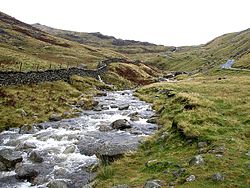NGC 1549
NGC 1549| NGC 1549 | |
|---|---|
 NGC 1549 by 2MASS | |
| 관측 데이터(J2000 epoch) | |
| 별자리 | 도라도 |
| 우측 상승 | 04h 15m 45.1s[1] |
| 탈위임 | −55° 35′ 32″[1] |
| 레드시프트 | 0.004190 ± 0.000040 [1] |
| 헬리오 방사 속도 | 1,256 ± 12km/s[1] |
| 거리 | 51.2 ± 14 Mly(15.7 ± 4.4 Mpc)[1] |
| 그룹 또는 클러스터 | 도라도 그룹 |
| 겉보기 크기 (V) | 9.6 |
| 특성. | |
| 유형 | E0-1 [1] |
| 겉보기 크기 (V) | 4′.9 × 4′.1[1] |
| 기타 지정 | |
| ESO 157-G16, AM 0414-554, PGC 14757[1] | |
NGC 1549는 도라도 별자리에 위치한 타원 은하다. 그것은 지구로부터 약 5천만 광년 거리에 위치해 있는데, 이것은 명백한 치수로 볼 때 NGC 1549가 지름이 약 7만 5천 광년이라는 것을 의미한다. NGC 1549는 1835년 12월 6일 존 허셜에 의해 발견되었고 1826년 제임스 던롭에 의해 관찰되었을지도 모른다.[2] 도라도 그룹의 일원이다.
NGC 1549의 중심에는 초질량 블랙홀이 놓여 있을 것으로 예상되는데, 이 블랙홀의 질량은 은하 세르식 지수를 기준으로 3억 9천만에서 8억 1천만 (108.76+0.15
−0.17) 사이로 추정된다.[3] 성간 먼지의 존재에 대한 지표인 다순환 방향족 탄화수소(PAHs) 배출이 스피처 우주 망원경에 탑재된 적외선 분광기에 의해 검출되지 않았다.[4] NGC 1549는 0.3~5 keV 대역의 총 유속이 2×1040 ergs s–1을 초과하여 X선을 방출하는 것으로 밝혀졌다.[5] NGC 1549에는 총 150개의 구상 성단이 존재할 것으로 추정되며, 이는 유사한 크기의 은하수에 비해 낮은 수이다.[6] 은하의 바깥쪽 이소포트는 뒤틀려 보이고 희미한 조개껍질이 특징이다.[7]
NGC 1549는 렌즈콩 은하 NGC 1553과 상호작용하는 한 쌍을 형성하며, 이는 남쪽으로 12 아크 분에 놓여 있다.[8] 도라도그룹으로 알려진 적당한 크기의 은하군에서 가장 큰 타원형 은하다.[9]
참조
- ^ a b c d e f g h "NASA/IPAC Extragalactic Database". Results for NGC 1549. Retrieved 2016-01-18.
- ^ Seligman, Courtney. "NGC 1549 (= PGC 14757)". Celestial Atlas. Retrieved 19 November 2018.
- ^ Mutlu-Pakdil, Burçin; Seigar, Marc S.; Davis, Benjamin L. (17 October 2016). "The local black hole mass function derived from the MBH-P and the MBH-n relations". The Astrophysical Journal. 830 (2): 117. arXiv:1607.07325. Bibcode:2016ApJ...830..117M. doi:10.3847/0004-637X/830/2/117. S2CID 118586684.
- ^ Kaneda, H.; Onaka, T.; Sakon, I.; Kitayama, T.; Okada, Y.; Suzuki, T. (September 2008). "Properties of Polycyclic Aromatic Hydrocarbons in Local Elliptical Galaxies Revealed by the Infrared Spectrograph on Spitzer". The Astrophysical Journal. 684 (1): 270–281. arXiv:0805.3257. Bibcode:2008ApJ...684..270K. doi:10.1086/590243. S2CID 14065147.
- ^ Diehl, Steven; Statler, Thomas S. (10 October 2007). "The Hot Interstellar Medium of Normal Elliptical Galaxies. I. A Chandra Gas Gallery and Comparison of X-Ray and Optical Morphology". The Astrophysical Journal. 668 (1): 150–167. arXiv:astro-ph/0606215. Bibcode:2007ApJ...668..150D. doi:10.1086/521009. S2CID 14507041.
- ^ Bridges, Terry J.; Hanes, David A. (April 1990). "Globular clusters in the interacting galaxies NGC 1549 and NGC 1553". The Astronomical Journal. 99: 1100. Bibcode:1990AJ.....99.1100B. doi:10.1086/115399.
- ^ Franx, Marijn; Illingworth, Garth; Heckman, Timothy (August 1989). "Multicolor surface photometry of 17 ellipticals" (PDF). The Astronomical Journal. 98: 538. Bibcode:1989AJ.....98..538F. doi:10.1086/115157. hdl:1887/6554.
- ^ de Vaucouleurs, G.; de Vaucouleurs, A.; Corwin, J. R. (1976). "Second reference catalogue of bright galaxies". Second Reference Catalogue of Bright Galaxies. 1976. Bibcode:1976RC2...C......0D.
- ^ Kilborn, V. A.; Koribalski, B. S.; Forbes, D. A.; Barnes, D. G.; Musgrave, R. C. (1 January 2005). "A wide-field HI study of the NGC 1566 group". Monthly Notices of the Royal Astronomical Society. 356 (1): 77–88. arXiv:astro-ph/0409743. Bibcode:2005MNRAS.356...77K. doi:10.1111/j.1365-2966.2004.08450.x.
외부 링크
 Wikimedia Commons에서 NGC 1549와 관련된 미디어
Wikimedia Commons에서 NGC 1549와 관련된 미디어- NGC 1549 on WikiSky: DSS2, SDSS, GALEX, IRAS, 수소 α, X선, 아스트로포토, 스카이맵, 기사 및 이미지
- NGC 1549 on SIMBAD


